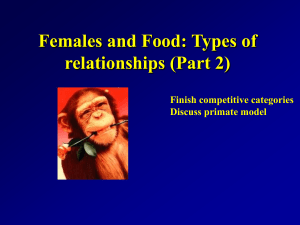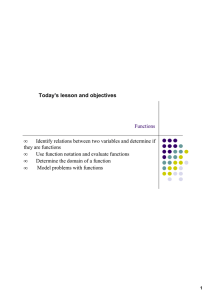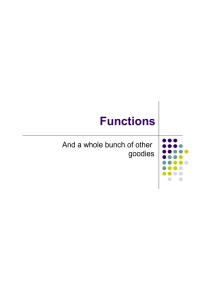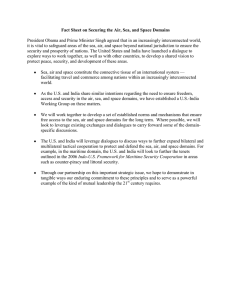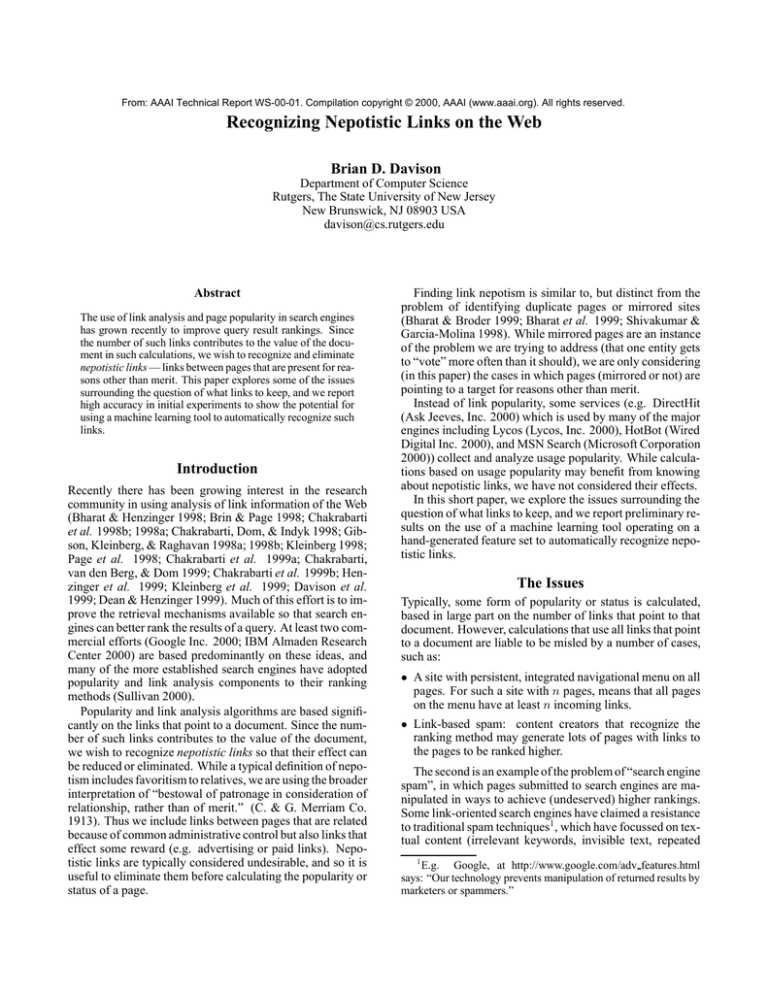
From: AAAI Technical Report WS-00-01. Compilation copyright © 2000, AAAI (www.aaai.org). All rights reserved.
Recognizing Nepotistic Links on the Web
Brian D. Davison
Department of Computer Science
Rutgers, The State University of New Jersey
New Brunswick, NJ 08903 USA
davison@cs.rutgers.edu
Abstract
The use of link analysis and page popularity in search engines
has grown recently to improve query result rankings. Since
the number of such links contributes to the value of the document in such calculations, we wish to recognize and eliminate
nepotistic links — links between pages that are present for reasons other than merit. This paper explores some of the issues
surrounding the question of what links to keep, and we report
high accuracy in initial experiments to show the potential for
using a machine learning tool to automatically recognize such
links.
Introduction
Recently there has been growing interest in the research
community in using analysis of link information of the Web
(Bharat & Henzinger 1998; Brin & Page 1998; Chakrabarti
et al. 1998b; 1998a; Chakrabarti, Dom, & Indyk 1998; Gibson, Kleinberg, & Raghavan 1998a; 1998b; Kleinberg 1998;
Page et al. 1998; Chakrabarti et al. 1999a; Chakrabarti,
van den Berg, & Dom 1999; Chakrabarti et al. 1999b; Henzinger et al. 1999; Kleinberg et al. 1999; Davison et al.
1999; Dean & Henzinger 1999). Much of this effort is to improve the retrieval mechanisms available so that search engines can better rank the results of a query. At least two commercial efforts (Google Inc. 2000; IBM Almaden Research
Center 2000) are based predominantly on these ideas, and
many of the more established search engines have adopted
popularity and link analysis components to their ranking
methods (Sullivan 2000).
Popularity and link analysis algorithms are based significantly on the links that point to a document. Since the number of such links contributes to the value of the document,
we wish to recognize nepotistic links so that their effect can
be reduced or eliminated. While a typical definition of nepotism includes favoritism to relatives, we are using the broader
interpretation of “bestowal of patronage in consideration of
relationship, rather than of merit.” (C. & G. Merriam Co.
1913). Thus we include links between pages that are related
because of common administrative control but also links that
effect some reward (e.g. advertising or paid links). Nepotistic links are typically considered undesirable, and so it is
useful to eliminate them before calculating the popularity or
status of a page.
Finding link nepotism is similar to, but distinct from the
problem of identifying duplicate pages or mirrored sites
(Bharat & Broder 1999; Bharat et al. 1999; Shivakumar &
Garcia-Molina 1998). While mirrored pages are an instance
of the problem we are trying to address (that one entity gets
to “vote” more often than it should), we are only considering
(in this paper) the cases in which pages (mirrored or not) are
pointing to a target for reasons other than merit.
Instead of link popularity, some services (e.g. DirectHit
(Ask Jeeves, Inc. 2000) which is used by many of the major
engines including Lycos (Lycos, Inc. 2000), HotBot (Wired
Digital Inc. 2000), and MSN Search (Microsoft Corporation
2000)) collect and analyze usage popularity. While calculations based on usage popularity may benefit from knowing
about nepotistic links, we have not considered their effects.
In this short paper, we explore the issues surrounding the
question of what links to keep, and we report preliminary results on the use of a machine learning tool operating on a
hand-generated feature set to automatically recognize nepotistic links.
The Issues
Typically, some form of popularity or status is calculated,
based in large part on the number of links that point to that
document. However, calculations that use all links that point
to a document are liable to be misled by a number of cases,
such as:
• A site with persistent, integrated navigational menu on all
pages. For such a site with n pages, means that all pages
on the menu have at least n incoming links.
• Link-based spam: content creators that recognize the
ranking method may generate lots of pages with links to
the pages to be ranked higher.
The second is an example of the problem of “search engine
spam”, in which pages submitted to search engines are manipulated in ways to achieve (undeserved) higher rankings.
Some link-oriented search engines have claimed a resistance
to traditional spam techniques1, which have focussed on textual content (irrelevant keywords, invisible text, repeated
1
E.g. Google, at http://www.google.com/adv features.html
says: “Our technology prevents manipulation of returned results by
marketers or spammers.”
terms, etc), but are instead vulnerable to linkage spam. This
influence can be found in varying amounts from sites with
various levels of content quality.
About.com, for example, is a high-quality site that not
only uses an integrated navigational menu, but separates
much of its content into URLs with distinct host-names.
Intentional or not, this has the effect of getting more pages
indexed and raising its relevance rankings with many search
engines, based on the matching of keywords in host-names
and by getting around simple heuristics to recognize internal
links (see below). At Google, for example, out of the
first 200 pages listed as pointing to www.about.com,
only 5 were from domains other than about.com. The
rest were subject pages within the site, such as #108:
http://billiardspool.about.com/sports/
billiardspool/mbody.htm.
Another example is the doorkey.com site, which (as of
this writing) consists of a large set of pages that link to one
another, but have little or no actual content (and sometimes
include obvious keyword placement) but just link to advertisers and other doorkey-operated sites (many of which are
domain names that are only a typo away from a popular domain, such as eba6.com and mapquesy.com). Finally,
there are networks of sites in which otherwise unrelated sites
that point to one another (for the explicit purpose of raising
search engine rankings), such as linkstoyou.com.
There are a number of general approaches to combat this
problem, including:
• maintain an exception list of pages that are abusing the incoming links
• use a heuristic to drop “internal” links (pre-processing)
• recognize when the results of a search are influenced
by the ’spam’ and adjust the results accordingly (postprocessing)
It is not always clear exactly what methods the commercial search engines are using; however many researchers
have suggested some form of the second method (e.g.
(Kleinberg 1998)). Unfortunately, any simple heuristic is
likely to have significant exceptions. For example:
• marking links between pages with identical host-names as
internal
– drops links between different users’ home pages at the
same site.
– preserves links between different hosts in the same domain.
• marking links between pages with identical domain names
– drops links between different users’ pages at same site
(as above).
– drops links between departments of same organization
(regardless of whether they are on different servers).
Both additionally allow links from different domains and advertising to affect link analysis.
In general, the problem is not really to identify which links
are internal, but instead to recognize which links should be
used and which should not be used in link calculations. Often this means keeping links between pages from two different people/groups/owners, and dropping those between
pages under the same administrative control, regardless of
differences in domain name, content, etc. Often, one would
like to treat links as votes, and we wish to prevent voting for
one’s self. Additionally, links that exist as a byproduct of advertising (such as some banner swap services) are unlikely to
be useful for link analysis. If links are dropped, the resulting
graph is smaller and faster to analyze. Dropping is not the
only option; if link weights are supported, then the weights
for these links can be reduced significantly in comparison to
those that are believed to be useful.
In truth, the issue is even more complex than described
above. In link analysis, the links between pages are often
considered to be recommendations. And as such, unbiased
recommendations are desirable. However, some companies
with networks of independent sites (e.g. companies like
internet.com, about.com, go2net.com, etc.) may
have both biased and unbiased links between sites (which
may be indistinguishable), and in some cases, successful
links may predate and have encouraged commercial partnerships or corporate takeovers. Additionally, even biased links
facilitate traffic flow, which is important for usage popularity. Finally, to prevent negative publicity, search engines are
unlikely to use any mechanism that smacks (at least overtly)
of censorship. Therefore, we believe most will avoid the use
of an exception list, which additionally has the drawback of
only covering the previously identified cases.
The use of a post-processing approach has some advantages, such as keeping the primary algorithm and datasets
pure, but is highly algorithm-specific, and so we do not
consider it further. Instead, we focus on the use of preprocessing to clean and reduce the link dataset before calculations are performed. In the next section, we consider
the use of machine learning techniques to learn a potentially
complex rule to recognize nepotistic links.
Preliminary Experiments
In order to assess the potential for automatic recognition of
nepotistic links, we performed some initial classification experiments. The C4.5 decision tree package (Quinlan 1993)
was selected for these preliminary tests because of its value
as a popular and well-understood learning system, but a variety of other approaches could be equally useful.
Data Sets
Two data sets were used. For the first, we manually labeled
1536 links (that is, pairs of pages in which the first contains
a reference to the second) selected arbitrarily to include data
points from many types of pages, and then cleaned the labelings so that each link had exactly one label, specifying
whether or not the link is nepotistic. The primary concern
with this dataset is that it was selected with the task in mind,
and thus is unlikely to be representative of the links on the
Web as a whole. Therefore, we also generated a second set
of data.
For this second dataset we randomly sampled the link
FromPath contains tilde = 0:
|
From contains Simple gTLD = 0:
|
|
Domains are same = 0: -1 (35.0)
|
|
Domains are same = 1: 1 (30.0/1.0)
|
From contains Simple gTLD = 1:
|
|
FromPage has > 200 links = 1: 1 (812.0)
|
|
FromPage has > 200 links = 0:
|
|
|
Same DNS servers = 0:
|
|
|
|
Same contact email = 1: 1 (5.0)
|
|
|
|
Same contact email = 0:
|
|
|
|
|
Pages share > 10% links = 0: -1 (62.0/7.0)
|
|
|
|
|
Pages share > 10% links = 1: 1 (3.0/1.0)
|
|
|
Same DNS servers = 1:
|
|
|
|
Complete hostnames are same = 1: 1 (374.0)
|
|
|
|
Complete hostnames are same = 0:
|
|
|
|
|
Domains are same = 0: 1 (68.0/1.0)
|
|
|
|
|
Domains are same = 1:
|
|
|
|
|
|
Pages share > 20% links = 1: 1 (18.0)
|
|
|
|
|
|
Pages share > 20% links = 0:
|
|
|
|
|
|
|
FromPage has > 100 links = 1: 1 (14.0)
|
|
|
|
|
|
|
FromPage has > 100 links = 0:
|
|
|
|
|
|
|
|
FromPage has <= 5 links = 1: 1 (2.0)
|
|
|
|
|
|
|
|
FromPage has <= 5 links = 0:
|
|
|
|
|
|
|
|
|
1 path components are same = 1: -1 (5.0/2.0)
|
|
|
|
|
|
|
|
|
1 path components are same = 0:
|
|
|
|
|
|
|
|
|
|
FromPage has <= 10 links = 0: 1 (21.0/6.0)
|
|
|
|
|
|
|
|
|
|
FromPage has <= 10 links = 1: -1 (5.0/2.0)
FromPath contains tilde = 1:
|
1 path components are same = 0: -1 (56.0)
|
1 path components are same = 1: 1 (26.0)
Figure 1: One decision tree generated by C4.5. Each line shows the test, its validity, and for leaf nodes, whether the rule is
to classify as nepotistic (labeled 1) or good (labeled -1), and the training set statistics showing the number of cases correctly
covered followed by the number incorrectly covered, if any (in parantheses).
dataset from over 7 million pages of the DiscoWeb search engine (Davison et al. 1999) for links in which both the source
and the target had been indexed. 750 such links were then
manually labeled. While potentially containing less bias, this
dataset is likely to under-represent some types of pages because of the small sample size.
The overall class probabilities of the two datasets differ:
89.5% of the links in the first set were labeled nepotistic,
vs. 72.8% of the second. When described by all possible features (described below), the first data set contained
255 unique cases, vs. 535 distinct cases in the second, and
of these, the cases labeled nepotistic comprised 72.1% and
78.6% respectively.
• Some number of initial IP address octets were identical
Feature Definition
• The domains were simple Global Top-Level Domains (i.e.
.com, .net, .org, and .edu)
A non-exhaustive set of seventy-five binary features were
defined manually, including tests to see if:
• Page titles or descriptions were identical
• Page descriptions overlapped at least some percentage of
text
• Complete host-names were identical
• Domain names were identical
• Host-names without domains were identical
• Some number of initial path components were identical
• The parent (from) page had more than some number of
outgoing links
• The pages shared at least some percentage of outgoing
links
• The parent page points to linkstoyou.com
• The parent page
“LinksToYou”
description
contains
the
term
• The paths contained keywords like “home”, “users”, or the
character ‘˜’ (tilde)
• The domains had the same contact email address (checked
only for the simple gTLD domains)
• The domains had the same DNS servers (checked only for
the simple gTLD domains)
These features were defined quickly with the expectation
that that additional features may be required, and that some
kind of feature selection would be useful, and possibly even
feature extraction would be needed to determine additional
60%
Error Rate
50%
40%
Train on first, test on second
Train on second, test on first
30%
20%
10%
0%
Base (46)
Base+links (59)
Base+text (71)
All (75)
Manual (24)
Feature Set
Figure 2: Error-rate of single decision tree for each of five feature sets (with the number of features in parentheses).
strings on which to test. See figure 1 for an example of these
features in use in a decision tree.
To begin the process of feature selection based on domain
knowledge, the features were placed in the following groups:
• base set: features about the URL strings for the pair of
pages
• base+links: the above plus outgoing links and IP addresses for the pair of pages
• base+text: base+links plus the title and description text
for the pair of pages
• all: everything above plus tests about contact email and
dns servers for the pair of page domains (only available
for domains in the simple gTLD domains)
These groups roughly correspond to the amount of time required to evaluate them. The base set is simple, requiring only the URL strings themselves. The base+links and
base+text sets use information typically already present in
a search engine database. The final group contains all features, including some that require access to external (potentially slow) domain databases. A fifth group, termed manual, was selected manually using one third of the features to
try to improve accuracy (which it does in the single decision
tree case).
Results
Experiments were run using C4.5 (using default options, no
pruning) with each set of features. Figure 2 shows the error
rates for a decision tree generated when trained on one set
and evaluated on the other. The large difference in error rates
shown in this graph gives strong evidence of a difference in
distributions between the two datasets. The example in figure 1 contains the decision tree generated by training on the
first dataset and testing on the second, using the manual feature set.
We also performed experiments with ten-fold crossvalidation on either data set alone and together, shown in figure 3. Very high average accuracy (>97%) is achieved on
the first data set. Average accuracies on second set and combined sets are not quite as good, at >91% and >93%, respectively.
For reference, we have also evaluated some common “internal link” heuristics. When labeling a link containing
matching host-names as nepotistic, the overall error rates are
64% for the first data set, and 18% for the second. The allocation of errors are shown below:
first
(a)
(b)
140 21
963 412
data set
<= classified as =>
(a): good link
(b): nepotistic link
second
(a)
(b)
203
1
134 412
When using only using matching domain names as the
heuristic for nepotistic links, the overall error rates are 60.6%
and 14.4%, respectively for the first and second data sets, as
shown below:
first
(a)
(b)
121 40
892 483
data set
<= classified as =>
(a): good
(b): nepotistic
second
(a)
(b)
201
3
103 443
Like the simple heuristics above, the decision trees generated errors that were highly skewed toward retaining links
that should have been marked as nepotistic. This is, in fact, a
desirable quality — one would prefer to allow a site to some
undue influence rather than potentially prevent a site from
scoring well.
0.1
Xval on first set only
Xval on second set only
Xval on combined sets
0.09
Error rate
0.08
0.07
0.06
0.05
0.04
0.03
0.02
0.01
0
Base (46)
Base+links (59)
Base+text (71)
All (75)
Manual (24)
Feature Set
Figure 3: Average error-rate of ten-fold cross-validation for each of five feature sets (with the number of features in parentheses).
Discussion
Data Sets and Results
The two datasets used in this paper represent a typical scenario: A search service, desiring to weed out linkage spam,
assembles a representative set of example links that include
both good links and nepotistic links that have been encountered. With only this dataset, it is easy to generate rules that
cover it well. The second dataset then represents the actual
links across the web (or at least across the service’s link data).
As expected, a decision tree generated from the first data set
doesn’t do quite as well on the second. The fact that the decision tree trained on the second set performs poorly on the first
suggests that the first dataset focuses on a few kinds of examples, and that the second does not cover those kinds well.
This too is relevant for two reasons: the second dataset is
likely to be too small to be truly representative, and the first
dataset (being manually collected from interesting or useful
examples) is likely to contain unusual or otherwise difficult
to classify cases (because that is what would get them noticed
and put into the set in the first place).
Therefore, we take the results presented here as initial evidence for the utility of automated learning methods for this
problem. We hesitate to make strong claims about these results as the data sets are quite small samples of the links on
the Web, and decision trees but one point in a large space of
possible learning methods that could be applied.
Level of Effort
Online commercial search engines are very concerned about
response-time and query costs. Some engines will respond
with partial data so that response-time is minimized, and
to restrict the amount of cpu time dedicated to any one
query. We have not seriously considered computational and
space requirements for this work, but expect that this process
would need to be performed off-line — perhaps incrementally while crawling or en masse for services whose dataset
is updated by batches. In any case, collecting and/or calculating some of the features is likely to take enough time that it
should stay out of a dynamic request stream, but the features
may change over time, so a static analysis is insufficient.
Future Work
While link nepotism addresses the issues of “voting for oneself” and having your vote purchased, there are other perversions of the traditional voting mechanisms. As mentioned
earlier, one that is of concern is the issue of duplicate pages
and mirror sites — it may be desirable to consider links from
those pages as “duplicate votes”. In general this problem can
manifest itself in multiple links from pages of one organization pointing to a page in a second organization. Such links,
whether on duplicate or distinct pages, may produce undue
support for the target page. Measuring the pervasiveness of
this problem and the effectiveness of enforcing a “one person, one vote” rule is left for future work.
Conclusion
For truly popular pages, the efforts discussed in this paper
are unlikely to affect results much, as most of their incoming links will be from unrelated external sites. However, the
results of queries on less-popular topics may be undermined
by savvy content creators. This paper has presented some of
the issues surrounding the idea of eliminating nepotistic links
from analysis, and demonstrated the potential for automatic
recognition of such links with high accuracy.
Acknowledgments
This work benefits greatly from the systems, work, and discussions of the other members of the DiscoWeb research
group: Apostolos Gerasoulis, Wei Wang, Hyun-ju Seo, Konstantinos Kleisouris, and Junyu Tian, and is supported in
part by ARPA under Order Number F425 (via ONR contract
N6600197C8534).
References
Ask Jeeves, Inc.
2000.
Direct Hit home page.
http://www.directhit.com/.
Bharat, K., and Broder, A. 1999. Mirror, mirror on the web:
a study of host pairs with replicated content. In Proceedings
of the Eighth International World Wide Web Conference.
Bharat, K., and Henzinger, M. R. 1998. Improved Algorithms for Topic Distillation in Hyperlinked Environments.
In Proceedings of the 21st International ACM SIGIR Conference on Research and Development in Information Retrieval, 104–111.
Bharat, K.; Broder, A.; Dean, J.; and Henzinger, M. 1999.
A comparison of techniques to find mirrored hosts on the
WWW. In Proceedings of the ACM Digital Library Workshop on Organizing Web Space (WOWS).
Brin, S., and Page, L. 1998. The anatomy of a large-scale
hypertextual web search engine. In Proceedings of the Seventh International World Wide Web Conference.
C. & G. Merriam Co. 1913. Webster’s revised unabridged
dictionary. Online at http://www.dictionary.com/.
Chakrabarti, S.; Dom, B. E.; Gibson, D.; Kumar, R.;
Raghavan, P.; Rajagopalan, S.; and Tomkins, A. 1998a. Experiments in Topic Distillation. In ACM SIGIR Workshop
on Hypertext Information Retrieval on the Web.
Chakrabarti, S.; Dom, B. E.; Raghavan, P.; Rajagopalan,
S.; Gibson, D.; and Kleinberg, J. M. 1998b. Automatic
resource compilation by analyzing hyperlink structure and
associated text. In Proceedings of the Seventh International
World Wide Web Conference.
Chakrabarti, S.; Dom, B. E.; Gibson, D.; Kleinberg, J. M.;
Kumar, S. R.; Raghavan, P.; Rajagopalan, S.; and Tomkins,
A. 1999a. Hypersearching the Web. Scientific American.
Chakrabarti, S.; Dom, B. E.; Gibson, D.; Kleinberg, J. M.;
Kumar, S. R.; Raghavan, P.; Rajagopalan, S.; and Tomkins,
A. 1999b. Mining the web’s link structure. IEEE Computer
60–67.
Chakrabarti, S.; Dom, B. E.; and Indyk, P. 1998. Enhanced
hypertext categorization using hyperlinks. In Proceedings
of ACM SIGMOD.
Chakrabarti, S.; van den Berg, M.; and Dom, B. E. 1999.
Focused crawling: a new approach to topic-specific web resource discovery. In Proceedings of the Eighth International World Wide Web Conference.
Davison, B. D.; Gerasoulis, A.; Kleisouris, K.; Lu, Y.; Seo,
H.; Wang, W.; and Wu, B. 1999. DiscoWeb: Applying
Link Analysis to Web Search. In Poster proceedings of
the Eighth International World Wide Web Conference, 148–
149.
Dean, J., and Henzinger, M. R. 1999. Finding related pages
in the world wide web. In Proceedings of the Eighth International World Wide Web Conference, 389–401.
Gibson, D.; Kleinberg, J. M.; and Raghavan, P. 1998a.
Inferring web communities from link topology.
In
Proceedings of the 9th ACM Conference on Hypertext
and Hypermedia (Hypertext’98). Expanded version at
http://www.cs.cornell.edu/home/kleinber/.
Gibson, D.; Kleinberg, J. M.; and Raghavan, P. 1998b.
Structural Analysis of the World Wide Web. In World Wide
Web Consortium Workshop on Web Characterization. Invited position paper.
Google Inc.
2000.
Google home page.
http://www.google.com/.
Henzinger, M. R.; Heydon, A.; Mitzenmacher, M.; and Najork, M. 1999. Measuring index quality using random
walks on the web. In Proceedings of the Eighth International World Wide Web Conference, 213–225.
IBM Almaden Research Center.
2000.
The CLEVER Project.
Home page:
http://www.almaden.ibm.com/cs/k53/clever.html.
Kleinberg, J. M.; Kumar, S.; Raghavan, P.; Rajagopalan, S.;
and Tomkins, A. 1999. The web as a graph: Measurements,
models and methods. In Proceedings of the International
Conference on Combinatorics and Computing. Invited survey.
Kleinberg, J. M.
1998.
Authoritative sources
in a hyperlinked environment.
In Proceedings
of the ACM-SIAM Symposium on Discrete Algorithms (SODA-98), 668–677.
Expanded version at
http://www.cs.cornell.edu/home/kleinber/.
Lycos, Inc. 2000. Lycos: Your personal internet guide.
http://www.lycos.com/.
Microsoft Corporation. 2000. MSN Search home page.
http://search.msn.com/.
Page, L.; Brin, S.; Motwani, R.; and Winograd, T. 1998.
The PageRank citation ranking: Bringing order to the
web.
Unpublished draft available from http://wwwdb.stanford.edu/˜backrub/pageranksub.ps.
Quinlan, J. R. 1993. C4.5: Programs for Machine Learning. San Mateo, CA: Morgan Kaufmann.
Shivakumar, N., and Garcia-Molina, H. 1998. Finding
near-replicas of documents on the web. In Proceedings of
Workshop on Web Databases (WebDB’98). Held in conjuntion with EDBT’98.
Sullivan, D.
2000.
Search Engine Watch.
http://www.searchenginewatch.com/.
Wired Digital Inc.
2000.
HotBot home page.
http://hotbot.lycos.com/.

